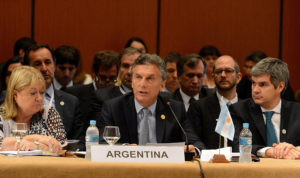Barely ten days after Chile’s new president, Sebastián Piñera, had taken office, he welcomed Jin Liqun, president of the Asian Infrastructure Investment Bank (AIIB), to the reception room of the Moneda presidential palace. This was a sign of continuity in Chile’s approach strategies to Asia, and especially China, a key area in Chile’s foreign trade. Previously, in May 2017, the then president Michelle Bachelet, had confirmed Chile’s interest in becoming a member whilst at the bank’s headquarters in Beijing. Now, the new Head of State is looking to advance the talks.
During the meeting, Jin explained the AIIB’s medium and long-term proposals. He indicated that the Belt and Road Initiative (BRI) is a priority in his plans as it seeks to create new 21st century links between Asia, Europe and North Africa. But he also stressed that another key objective was to promote economic cooperation with emerging states and to give a leadership role to countries of the Global South. In mid-2017, of the US$100 billion that made up its capital base, the bank estimated it will allocate 75% to countries of the Asia Pacific region and the rest to non-regional countries, provided they give some kind of support to the initiative.
Can Chile become part of that scenario when it is on the other side of the world? The answer is linked to China’s needs and those of the countries of Southeast Asia, which can be met from the South American region. There are mineral resources, such as copper from Chile, but there are also agricultural products from Argentina, Paraguay and Brazil that need to reach the Pacific in order to get to Asian markets. This necessitates building new roads and tunnels to traverse the mountain range, modern ports, and airports with ample and efficient cargo areas. It also requires having digital networks and processing capabilities where artificial intelligence will play an important role. All of this brings with it with new energy requirements, where alternative resources are increasingly necessary.
The AIIB will have to build that trust relationship step by step, or rather, project by project.
“Chile is one country that has been invited to be a member of the Bank. Congress will have to ratify whether we are to be a part, but it could be an attractive source of financing for Chile’s infrastructure projects, especially large-scale projects which link trade between Chile and Asia”, said economy minister José Ramón Valente at the conclusion of the meeting. Also present were finance minister Felipe Larraín and Rodrigo Yáñez, general director of international economic relations. It is expected that before the end of this year, the Chilean parliament will issue a statement on the matter.
The Bank can carry out its operations by granting direct loans, investing in capital holdings of institutions or companies, guaranteeing loans for economic development, allocating special funds, providing technical assistance, or using other types of financing as determined by the board of governors.
With all that said, it is clear that that locally, there is no insight into the AIIB as a possible priority source from which to draw finance for major projects. There is still a long way to go in the areas of trust, knowledge of the methodology, specific conditions for the granting of credits, and everything else that has been so far been done by the Inter-American Development Bank, or CAF – Development Bank of Latin America, well-known and trusted sources say. The AIIB will have to build that trust relationship step by step, or rather, project by project.
Yet, in the political framework there is progress, and the II Community of Latin American and Caribbean States (CELAC)-China Forum, held in Chile, brought about recognition of China’s potential as a new source of financing for major projects. The Special Declaration by CELAC members on the BRI, something that Chinese diplomacy did not initially expect, proclaimed that Latin American and Caribbean countries “welcomed with interest the Chinese foreign minister’s presentation on the Belt and Road Initiative as a way of strengthening cooperation between China and the countries of Latin America in the economic, commercial, investment, cultural and tourism sectors, among other areas”. Chinese foreign minister Wang Yi used the word ‘cooperation’ many times and remarked that “China is willing to continue considering them as important, priority partners” with the joint construction of the BRI being a common development goal.
Projects such as the Agua Negra (Black Water) Pass connecting Chile and Argentina over the Andes mountain range to the north, the high-speed Santiago-Valparaíso train, the installation of an underwater fibre optic cable between China and the Chilean coast, the expansion of the ports of San Antonio, or the Bi-Oceanic Corridor between the Pacific and the Atlantic via Chile, Argentina, Paraguay and Brazil, are concrete issues on the horizon of Chile’s dialogue with China. For now, they have not been raised with the AIIB, but when the time comes, that entity can become the attractive funding source of which Minister Valente spoke. Naturally, they are topics that will surely be on the agenda of future meetings between President Piñera and the Chinese president who will meet again when the G20 is held in Buenos Aires later this year, and certainly during the Asia-Pacific Economic Cooperation (APEC) 2019 meeting in Chile.








